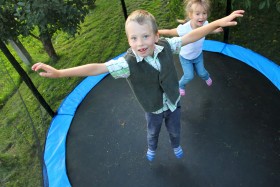The Dangers of Home Trampolines

It’s completely understandable for parents to want to encourage their children to be active and healthy. Since many kids love to bounce around on trampolines, it makes sense that many parents would consider purchasing a trampoline for their backyard thinking it would be a way to make being active fun. As fun as trampolines can be for kids, teenagers, and adults alike, trampolines can also be incredibly dangerous. Many doctors and pediatric health organizations, including the American Academy of Pediatrics and the Journal of Pediatric Orthopaedics, have spoken out about how incredibly dangerous trampolines are and strongly advise parents against buying them for their homes. Trampolines have such a reputation for being dangerous, many homeowner insurance policies don’t cover trampolines or will only cover trampolines if certain steps are taken.
Between 2002 and 2011, over a million people were sent to the emergency room because of trampoline injuries, 300,000 of which were broken bones. In 2009 alone, 98,000 injuries were caused by jumping on trampolines, which resulted in 3,100 hospitalizations. The Journal of Pediatric Orthopaedics estimates the emergency room expenses for trampoline related injuries from 2002-2011 totalled $1 billion, with $400 million of that covering fractures alone.
Kids 16 and under are the most likely to be injured on a trampoline, accounting for 92.7% of all injuries. Children 5 and under are the most likely to be significantly injured while on a trampoline. However, teenagers are more likely to sustain injuries to the face, spine, skull, and ribs because they are more likely to jump higher and take risks by attempting things like flips and somersaults. Some of the most common trampoline injuries include broken bones, fractures, concussions, head and neck injuries, and spinal injuries. Injuries commonly occur when a person bounces into another person, lands incorrectly, falls off the trampoline, or lands on the springs. Since flips and somersaults can result in spinal injuries if done incorrectly, they shouldn’t be attempted unless a person has been trained to do them properly.
There are many steps you can take to make trampolines safer, but unfortunately, many of them can create a false sense of security. Net enclosures around a trampoline and padding over springs are advisable, but haven’t yet been proven to make trampolines significantly safer since the majority of trampoline accidents happen on the main jumping surface of the trampoline. If kids are using a trampoline, adult supervision is very important so there is someone to stop kids if they start getting too close to the edge. But adult supervision can only do so much to prevent injuries; over half of trampoline injuries happen when there is adult supervision.
The best thing you can do to make trampolines safer is to only allow one person at a time on the trampoline. 75% of trampoline injuries occur when more than one person is on the trampoline at the same time. No amount of padding, netting, or adult supervision can change the simple fact that if two people are on a trampoline at once, the person who weighs less is 5 times more likely to sustain an injury than the heavier person.
The personal injury attorneys at the Law Offices of Goodwin & Scieszka handle other areas of childhood injury law, like playground injury claims or shallow water injury cases. Contact us to see how we can help.






